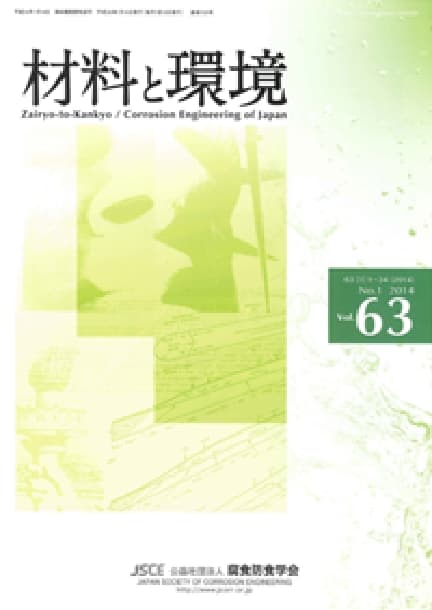- TOP
- Zairyo-to-Kankyo
- Vol. 63 (2014), No. 2
Zairyo-to-Kankyo Vol. 63 (2014), No. 2
Backnumber
-
Vol. 74 (2025)
-
Vol. 73 (2024)
-
Vol. 72 (2023)
-
Vol. 71 (2022)
-
Vol. 70 (2021)
-
Vol. 69 (2020)
-
Vol. 68 (2019)
-
Vol. 67 (2018)
-
Vol. 66 (2017)
-
Vol. 65 (2016)
-
Vol. 64 (2015)
-
Vol. 63 (2014)
-
Vol. 62 (2013)
-
Vol. 61 (2012)
-
Vol. 60 (2011)
-
Vol. 59 (2010)
-
Vol. 58 (2009)
-
Vol. 57 (2008)
-
Vol. 56 (2007)
-
Vol. 55 (2006)
-
Vol. 54 (2005)
-
Vol. 53 (2004)
-
Vol. 52 (2003)
-
Vol. 51 (2002)
-
Vol. 50 (2001)
-
Vol. 49 (2000)
-
Vol. 48 (1999)
-
Vol. 47 (1998)
-
Vol. 46 (1997)
-
Vol. 45 (1996)
-
Vol. 44 (1995)
-
Vol. 43 (1994)
-
Vol. 42 (1993)
-
Vol. 41 (1992)
-
Vol. 40 (1991)
Keyword Ranking
13 Dec. (Last 30 Days)
Zairyo-to-Kankyo Vol. 63 (2014), No. 2
Development of the Forecasting System of the Current from Sacrificial Anodes of Marine Structures using Data Assimilation
Naoki Yoneya, Yoshikazu Akira, Kenkichi Tashiro, Tomohiro Iida, Toru Yamaji, Kenji Amaya
pp. 43-49
DOI:
10.3323/jcorr.63.43Abstract
A new method for forecasting the current of sacrificial anodes using data assimilation was developed. In our system, In the framework of data assimilation, the system model forecasts the future state by the technical knowledge gained from experiments. The observation model corrects the forecasted result by the measurement information. In order to demonstrate the effectiveness and efficiency of our system, the verification experiment was performed at the real marine steel structures. The proposed method is expected to be a new approach for corrosion protection maintenance.
Practical Method for Estimating Time-Dependent Corrosion Depth of Uncoated Carbon Steel Plate under Atmospheric Environment using Fe/Ag Galvanic Couple ACM-Type Corrosion Sensor
Shigenobu Kainuma, Yuya Yamamoto, Hideyuki Hayashi, Yoshihiro Itoh, Wataru Oshikawa
pp. 50-57
DOI:
10.3323/jcorr.63.50Abstract
To maintain economically steel structures against corrosion damage, it is necessary to quantitatively clarify the corrosion environments of individual parts in the structures and to evaluate the time-dependent corrosion behavior. In this research, an evaluating method for the time-dependent corrosion depth of uncoated structural steel plates using Fe/Ag galvanic couple ACM type corrosion sensor was proposed. This method was focused on the environments with and without effect of rainfall and airborne sea salt. Atmospheric exposure tests were carried out on the uncoated steel plates in four fields in which the environments varied widely as a function of rainfall and airborne sea salt. In addition to this, the corrosive environments of the skyward- and groundward-facing surfaces of the plates were monitored using the ACM sensors.
Article Access Ranking
13 Dec. (Last 30 Days)
-
Delayed Fracture Mechanism of 1700 MPa-Class Quenched and Tempered Bolt under Atmospheric Corrosion Environment
Tetsu-to-Hagané Advance Publication
-
Perspectives on the Promising Pathways to Zero Carbon Emissions in the Steel Industry toward 2050
ISIJ International Vol.65(2025), No.2
-
Effect of B on Surface Oxidation Behavior and Phosphatability of Si-Mn-added Cold-Rolled Steel Sheets
ISIJ International Advance Publication
-
Factors Influencing the Bonding Phase Structure of Iron Ore Sinters
ISIJ International Vol.43(2003), No.9
-
Effect of microstructural heterogeneity on fatigue limit of as-quenched low-carbon low-alloy martensitic steel
ISIJ International Advance Publication
-
Prussian blue as a fully reversible hydrogenochromic material for visualizing hydrogen distribution in Fe sheet
ISIJ International Advance Publication
-
Progress of Strip Casting Technology for Steel; Historical Developments
ISIJ International Vol.52(2012), No.12
-
Research Progress on Optimal Blending of Iron Ore Powders for Sintering
ISIJ International Vol.65(2025), No.12
-
-
Microstructures and Reduction Properties of High CaO Concentration Sintered Ore
ISIJ International Advance Publication
You can use this feature after you logged into the site.
Please click the button below.










